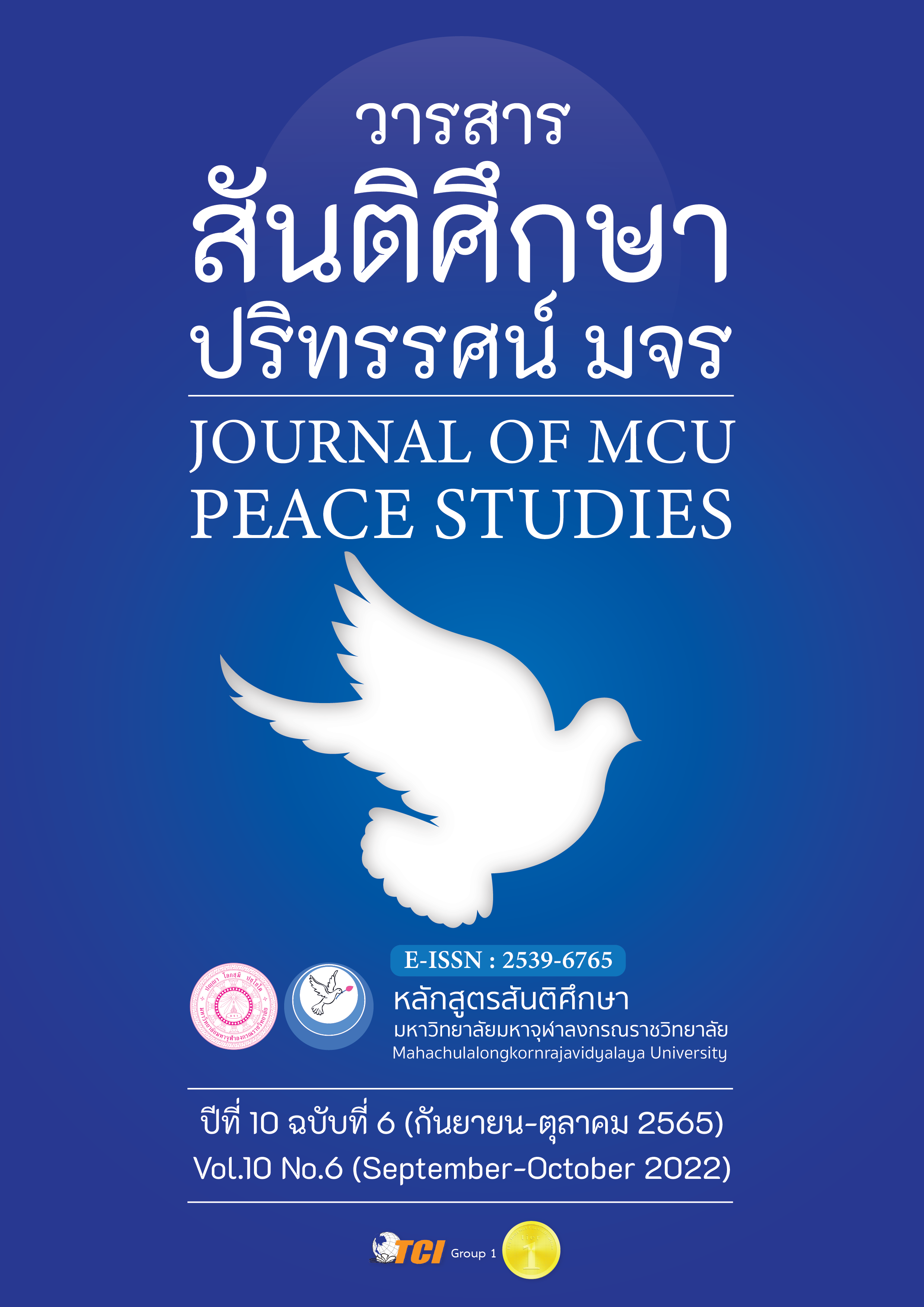การศึกษาการดูแลพระสงฆ์ที่เป็นโรคไตเรื้อรัง: ตั้งแต่การชะลอความเสื่อมของไต ขณะฟอกเลือดไตเทียม และการฟื้นฟูสมรรถภาพการประกอบกิจของสงฆ์
Main Article Content
บทคัดย่อ
บทความวิจัยนี้มีวัตถุประสงค์ 1) เพื่อศึกษาการดูแลการชะลอความเสื่อมของโรคไตเรื้อรังของพระสงฆ์ 2) เพื่อศึกษาเปรียบเทียบคุณภาพชีวิตของพระสงฆ์และฆราวาสที่เป็นไตเรื้อรังระยะสุดท้ายขณะฟอกเลือดไตเทียม 3) เพื่อศึกษาการฟื้นฟูสมรรถภาพการประกอบกิจของสงฆ์ การวิจัยนี้เป็นการวิจัยเชิงสำรวจ โดยการศึกษาภาคสนาม โดยใช้กลุ่มตัวอย่างเป็นพระสงฆ์ขณะที่ได้รับการฟอกเลือดด้วยเครื่องไตเทียมที่ห้องไตเทียม โรงพยาบาลสงฆ์ ไม่น้อยกว่า 2 ครั้ง ต่อสัปดาห์ จำนวน 30 รูป ได้มาโดยความสมัครใจ ผู้วิจัยให้ตอบแบบสอบถามมาตรฐานคือ การประเมินคุณภาพชีวิต (Quality of life : SF-36) ฉบับภาษาไทย และเครื่องมือสำหรับการประเมินภาวะซึมเศร้า (Depression score : The Thai Depression Inventory) เปรียบเทียบกับผู้ป่วยทั่วไปที่ฟอกเลือดเช่นเดียวกัน จำนวน 30 คน ผู้วิจัยเก็บข้อมูล ผลเลือด และบันทึกผลของสัญญาณชีพขณะที่ได้รับการฟอกเลือด ในช่วงเวลา 12 สัปดาห์ ในการวิเคราะห์ผลลัพธ์ของข้อมูล ใช้โปรแกรมสำเร็จรูป SPSS ของมหาวิทยาลัยมหิดล โดยการคำนวณหาค่าเฉลี่ย ค่าส่วนเบี่ยงเบนมาตรฐาน และค่านัยสำคัญทางสถิติโดยใช้ t-test
ผลการวิจัยพบว่า 1) การชะลอความเสื่อมของโรคไตเรื้อรังของพระสงฆ์ ได้แก่การลดน้ำหนัก การปรับนิสัยการฉัน การออกกำลังกาย การควบคุมความดันโลหิต การลดการมีโปรตีนรั่วในปัสสาวะ หลีกเลี่ยงสารหรือยาที่เป็นผลเสียต่อไต และการส่งต่อผู้ป่วยให้อายุรแพทย์โรคไต 2) คุณภาพชีวิตโดยรวมดีกว่าอย่างมีนัยสำคัญทางสถิติ ผลเลือดคือ ฟอสเฟต ความดันโลหิตตัวบน และชีพจร ดีขึ้นอย่างมีนัยสำคัญทางสถิติ ผลที่ดีขึ้นดังกล่าวอาจเป็นเพราะข้อต่อไปนี้ 3) การฟื้นฟูสมรรถภาพการประกอบกิจของสงฆ์ประกอบด้วยองค์ 4 (HEMS) คือวิธีแบบองค์รวม (Holistic Care =H) คือการดูแลร่วมกันระหว่างทีมผู้รักษา ผู้ดูแล และผู้ป่วย, การให้โอกาสตนเองในศึกษาหาความรู้เพิ่มเติม (Direct Experience = E) จาก Youtube, Tiktok, Google เป็นต้น, การช่วยเหลือจากสหสาขาวิชาชีพ (Multidisciplinary Care Team = M) และโดยการจัดการตนเอง (Self-Management = S) คือ การเลือกฉันอาหารโปรตีน การควบคุมปริมาณน้ำและเกลือแร่ การป้องกันภาวะแทรกซ้อน การดูแลเส้นเลือดที่ใช้ในการฟอกเลือด การออกกำลังกายและการดูแลตนเองทั้งด้านร่างกาย และจิตใจตามพระธรรมวินัย การไปฟอกเลือดได้สม่ำเสมอ
Article Details

อนุญาตภายใต้เงื่อนไข Creative Commons Attribution-NonCommercial-NoDerivatives 4.0 International License.
ทัศนะและความคิดเห็นที่ปรากฏในบทความในวารสาร ถือเป็นความรับผิดชอบของผู้เขียนบทความนั้น และไม่ถือเป็นทัศนะและความรับผิดชอบของกองบรรณาธิการ ยินยอมว่าบทความเป็นลิขสิทธิ์ของวารสาร
เอกสารอ้างอิง
Al Dukhayel, A. (2015). Prevalence of Depressive Symptoms Among Hemodialysis and Peritoneal Dialysis Patients. Int J Health Sci (Qassim), 9(1), 9-16.
Buathed, D. (2010). Buddhist Monks Health: A Model of Holistic Health Care by Community Participation in Upper Central Thailand. Mahasarakham University.
Carey, R. M. & Whelton P. K. (2018). ACC/AHA Hypertension Guideline Writing Committee. Prevention, Detection, Evaluation, and Management of High Blood Pressure in Adults: Synopsis of the 2017 American College of Cardiology/American Heart Association Hypertension Guideline. Ann Intern Med, 168(5), 351-358.
Davenport Andrew. (2003). “Peritoneal Host Defense in Patients with End-Stage Renal Failure Treated by Peritoneal Dialysis”. In The Infectious Complications of Renal Disease. Oxford: Oxford University Press.
Goh, Z. S., Griva, K. (2018). Anxiety and Depression in Patients with End-Stage Renal Disease: Impact and Management Challenges – A Narrative Review. Int J Nephrol Renovasc Dis, 11, 93-102.
Kasiske, B. L. et al. (1998). A Meta-Analysis of the Effects of Dietary Protein Restriction on the Rate of Decline in Renal Function. American Journal of Kidney Diseases, 31(6), 954-961.
Krittayaphong, R. et al. (2000). Reliability of Thai Version of SF-36 Questionnaire for the Evaluation of Quality of Life in Cardiac Patients. Journal of the Medical Association of Thailand, 83(2), 130-136.
Mahachulalongkornrajavidyalaya University. (1996). Thai Tipitaka. Bangkok: Maha Chulalongkorn Ratchawittayalai Press.
Micheal, J., Berkaben, Steve, J., & Schrvab, (2004). “Hemodialysis Vascular Access”. In Principles and Practice of Dialysis. (3rd Edition). Philadelphia: Lippincott Williams & Wilkins.
Jaingam, N. et. al. (2017). A Concept of Health Management for an Individual and Families Who Have Members with Chronic Diseases. Nursing Journal of The Ministry of Public Health, 27(3).
National Office of Buddhism. (2019). Statistics of Monks and Novices in Thailand.
Nauman, Siddqi, Sundaram, Hariharan, (2005). “Evaluation and Preparation of Renal Transplant Candidates”. In Handbook of Kidney Transplantation. (4th Edition). Philadelphia: Lippincott Williams & Wilkins.
Obrador, G. T., B. J., & Pereira, (1998). Early Referral to the Nephrologist and Timely Initiation of Renal Replacement Therapy: A Paradigm Shift in the Management of Patients with Chronic Renal Failure. American Journal of Kidney Diseases, 31(3), 398-417.
Phairatwet, P. et al. (2021). The Effect of Dhamma Practice on Depression Outcomes in Hemodialysis Patients. Journal of the Medical Association of Thailand, 104(1), 44-51.
Praneethum, W., Sitthijirapat, P., & Kiatkanont, K. (2018). Self-Care Behavior of Monks with Chronic Kidney Disease. Bangkok: Suan Sunandha Rajabhat University.
Reichard, P. et al. (1991). Intensified Conventional Insulin Treatment Retards the Microvascular Complications of Insulin-Dependent Diabetes Mellitus (IDDM): the Stockholm Diabetes Intervention Study (SDIS) After 5 Years. J Intern Med., 230, 101-108.
Ryan, P., & Sawin K. J. (2009). The Individual and Family Self-Management Theory: Background and Perspectives on Context, Process and Outcomes. Nursing outlook, 57(4), 217-256.
Thailand Renal Therapy Subcommittee: Nephrology Society of Thailand. (2019) Thailand Renal Replacement Therapy Year 2016-2019, Bangkok: The Nephrology Society of Thailand.
Thammachot, R. (2019) Caring for Sick Monks under the Principles of Dhamma Vinaya at Monk Hospital. Bangkok: Department of Medical Services, Ministry of Public Health.
The Nephrology Society of Thailand. (2022). Thai Renal Replacement Therapy (TRT Registry).
Vareesangthip, J. (2010). The Improvement of the Quality of Life of the End Stage Renal Disease Patients by Dhamma Practice. Bangkok: Amy Enterprise Company.
Vareesangthip, J. et al. (2016). A Study of the Effect of Anapanassati Kammatthana on the Quality of Life in Continuous Ambulatory Peritoneal Dialysis Patients. Journal of Graduate Studies Review, 12(3), 128-143.
Vongwiwatana, A. (2017). “Current Concepts in Management of Chronic Kidney Disease”. in Update on CKD Prevention: Strategies and Practical Points. (2nd Edition). Khon Kaen: Khon Kaen University Printing.


